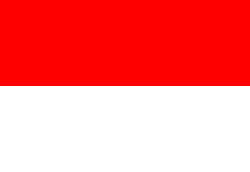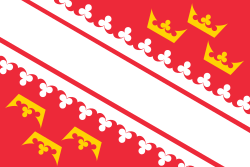You can help expand this article with text translated from the corresponding article in French. (September 2017)Click [show] for important translation instructions.
|
 | |
| Rot un Wiss | |
| Adopted | 11th century |
|---|---|
| Design | Red and white |
| Designed by | Gérard d'Alsace, Duke of Lorraine |
 The official flag of Alsace 2008–present | |
| Part of a series on |
| Alsace |
|---|
| |
| |
The flag of Alsace, known as the Red-and-White (Rot-un-Wiss in the Alsatian dialect), is the original red and white flag of the region, and can be traced to the red and white banner of Gerard, Duke of Lorraine in the 11th century.
Contents
- History
- Rot un Wiss (from the 11th century)
- Departmental and regional flags
- Recognition
- See also
- References
Particularly since the introduction of new French region Grand Est, the traditional Rot un Wiss flag of Alsace has been widely promoted by the advocates of the Alsace autonomous movement.









